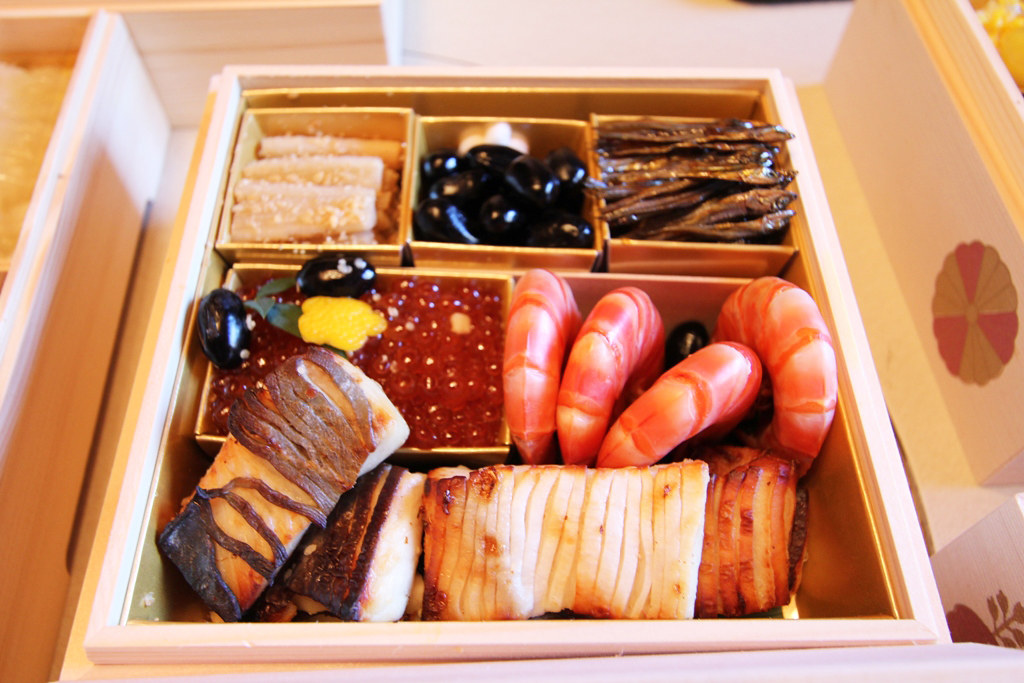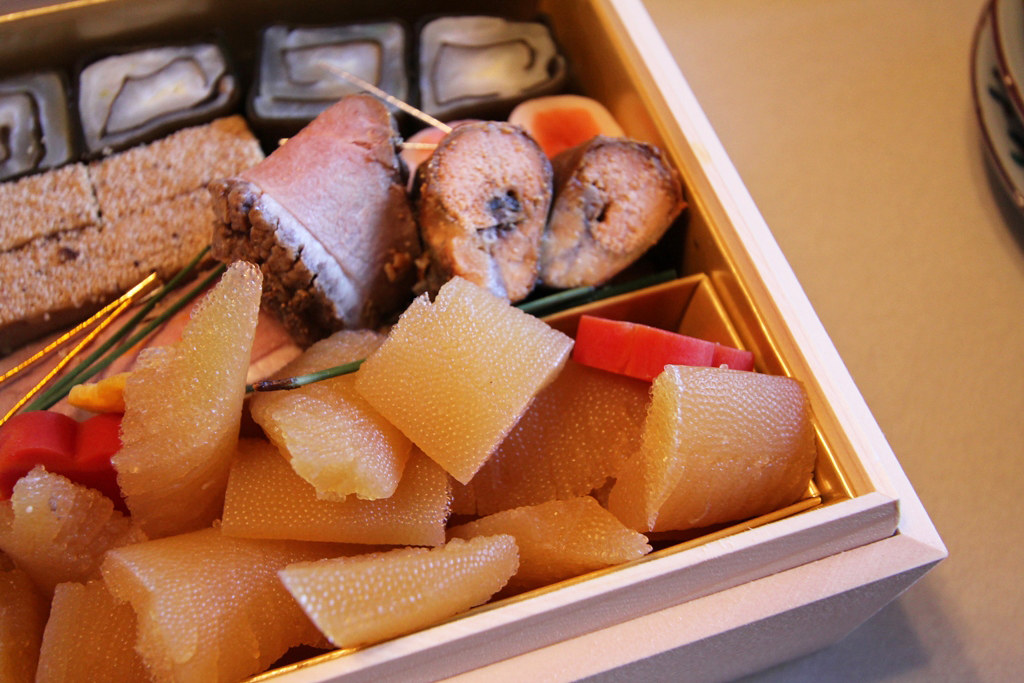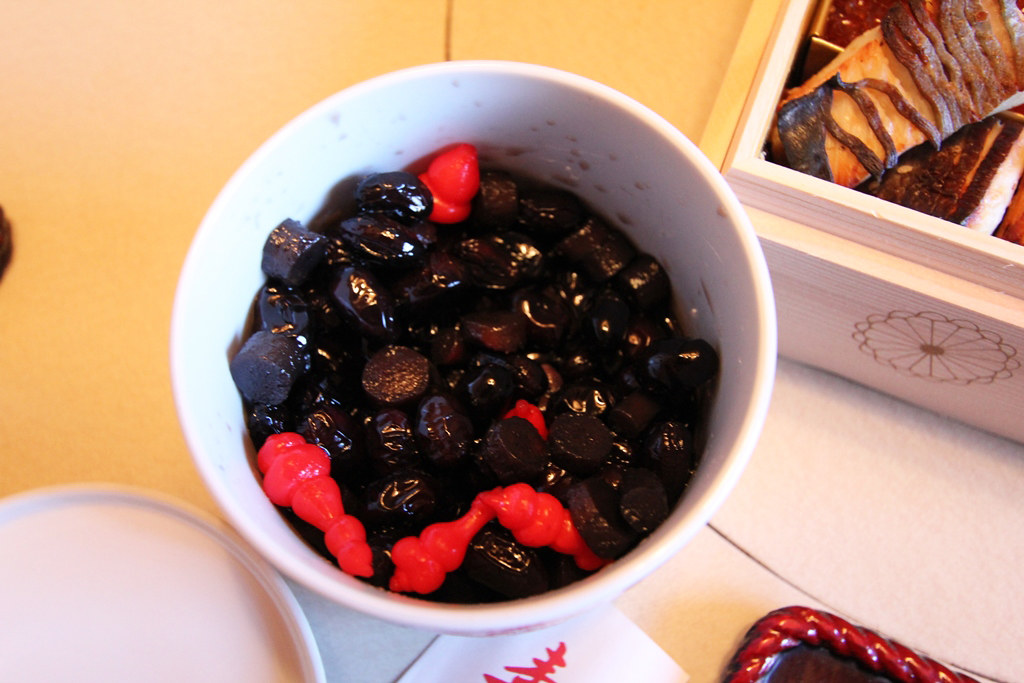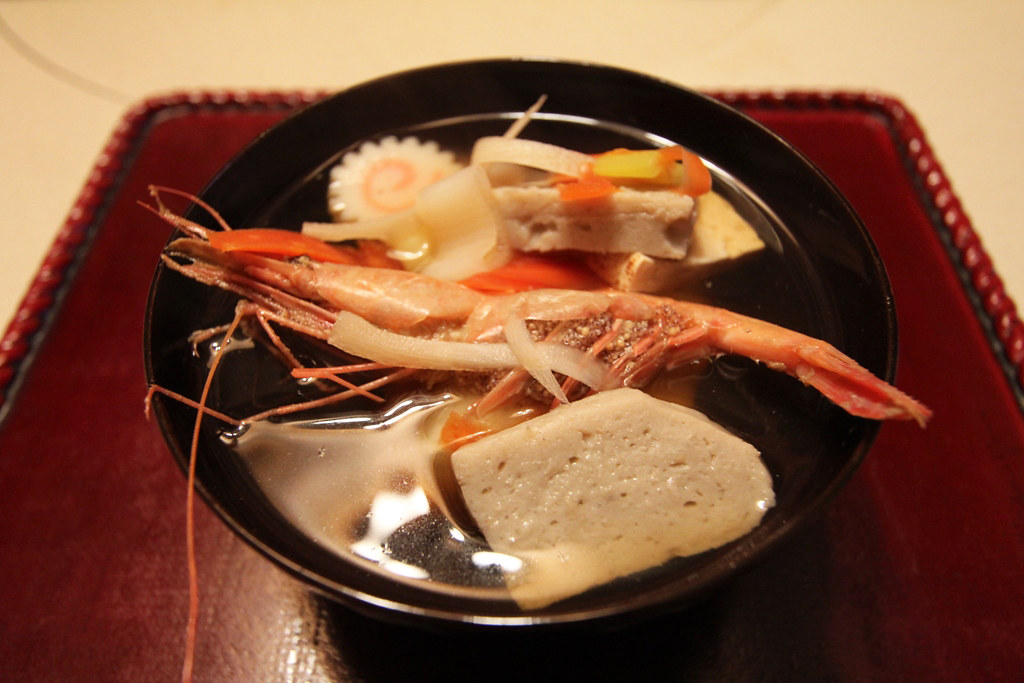ж∞іжЫЬжЧ•, 2жЬИ 2nd, 2011...10:06 AM
Osechi
Reading time: About 5 minutes
OsechiIn Japan, the traditional Japanese New Year foods are called osechi and are one of the things to look forward to for the New Year.
Originally, the food that was offered to the god on the beginning of each season was called osechi so it was not only for the New Year. However, the most important one was the New Year so the food during the New Year gradually monopolized the name вАЬosechiвАЭ. Normally you eat osechi on the first three days of the new year and they are gorgeous foods that can be kept for long. The bases of osechi are otoso, celebrating small dish, zoni, and nishime. The celebrating fish and nishime are put into jubako, a special box. The reason why the foods are stuffed into the box is to hope for good luck from stacking up the box, stacking up luck.
There are many good saying s and customs regarding osechi because they are originally foods for god and foods to hope good luck in the family. LetвАЩs check out some of the foods.
Celebrating Small Dish
Kazunoko (herring roe), kuro-mame (black soybeans), and tazukuri (dried sardines cooked in soysauce) are called the three small dishes and is a must for osechi.
Kazunoko (herring roe): Symbolizes a wish to be gifted with many children. Since herring is called вАЬnishinвАЭ which can be written as вАЬtwo parentsвАЭ, the saying comes from having many children from the вАЬtwo parentsвАЭ.
Kazunoko
Kuro-mame (black soybeans)пЉЪSymbolizes a wish to work вАЬmameniвАЭ (diligently) and live вАЬmameniвАЭ (in good healthвАЭ.
Tazukuri (dried sardines cooked in soy sauce)пЉЪSince small fish was used as fertilizer for rice fields, this dish symbolizes a wish for abundant harvest. Usually small Japanese anchovy are used.
Kuro-mame
Red and White Kamaboko (broiled fish paste)пЉЪThe half circle represents sunrise and red and white is the color of celebration.
Datemaki (sweet rolled omelette)пЉЪвАЭDateвАЭ means gorgeous and showy. The rolled up shape represent hanging scroll and books, a wish for growth in knowledge and culture.
Konbu-maki (rolled seaweed)пЉЪIncluded because вАЬkonbuвАЭ and the word вАЬyorokobuвАЭ meaning getting happy sounds alike.
Kuri Kinton (mashed sweet potato with sweet chestnut)пЉЪChestnut is known as auspicious food from вАЬkatchiguriвАЭ meaning winning kuri (chestnut). вАЬKintonвАЭ is written as golden sweets and since gold is a auspicious color, it symbolizes a wish to save up wealth.
Chorog (dyed red stachys affinis)пЉЪIt is wriiten as вАЬoldman happinessвАЭ and symbolizes a wish for long life. It is usually together with kuro-mame.
Tatakigobo (burdock)пЉЪThere is a wish for the family to florish as burdock that is deeply rooted in the ground.
Red and White Namasu (pickled daikon radish and carrot)пЉЪRepresents the celebration paper string and express celebration colors, red and white.
Grilled
Mainly fish that is said to be auspicious.
Buri (yellowtail)пЉЪSymbolize wish for success in work.
Tai (sea bream)пЉЪвАЭtaiвАЭ as in вАЬmedetaiвАЭ, meaning happy
ShrimpпЉЪA whish for living long until you have your back bent.
Nimono
Nimono is a simmered dishes and mainly mountain products.
Lotus RootпЉЪFor the wish of having a clear view of the future because it has a hole.
TaroпЉЪFor the wish of having many children because they grow many small potatoes.
ArrowheadпЉЪThe big sprout is вАЬmedetaiвАЭ and since they grow many small bulbs, a wish for many children is symbolized.
BurdockпЉЪSymbolizes a wish for the family to last for generations.
How to eat Osechi
There is a certain way to eat osechi.
The order is first, give a New Year greeting, and then eat from otoso, celebrating small dishes, osechi, and then ozoni.
The New Year foods are not only the foods in jubako box but osoto and ozoni as well.
When you eat osechi, you use celebrating chopsticks. This special chopstick has about 24 cm and gradually broadens. It is said to have good luck.
Both ends are thin and the meaning behind this is so that both god and people can eat at the same time, one end for the god and the other for us. By eating the same thing as the gods, it is said that we will receive the favor from he gods.
Otoso
Otoso is a New YearвАЩs sake. Unlike sake for the gods, it is not refined sake but sake with Chinese herb medicine. It is for familyвАЩs health.
The order to drink is supposed to be from the young to old.
Ozoni
A soup with mochi rice cakes that were offered to the gods, along with vegetables, chicken or fish. It is a meal that shows characteristic of each family.
Kanto Area: Soy sauce based and puts in square mochi that has been grilled.
Kansai Area: White miso based and puts in round mochi without grilling.
There are places where they put in mochi with anco (red beans paste) in it.
Ozoni



























Leave a Reply